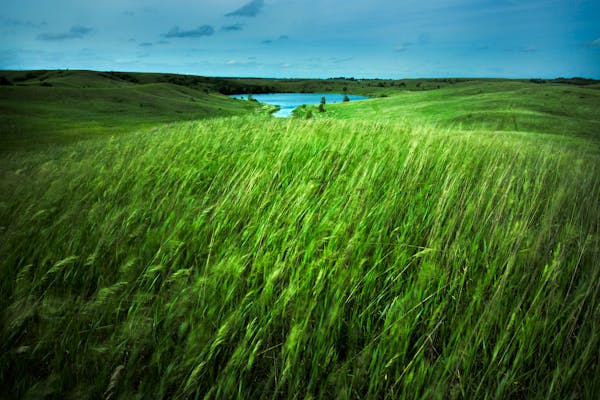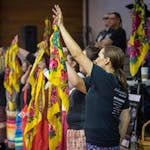As another June morning broke, Crow-Hassan Park Reserve's prairie world already hummed with activity. The white feathers of a meadowlark's tail flashed through the tall grass.
Vibrant butterfly weed welcomed delicate visitors. In places, the silver-gray of leadplant pushed up to the trail's edge. Nearby, white larkspur and purple lupin caught the eye.
And somewhere, no doubt, a bull snake kept residence in a pocket gopher hole.
To think all this has roots back to 1969, with 12 acres of tilled-up cornfield and a pickup bed full of prairie grass seed.
John Moriarty has walked this land for 30 years. He's learned the stories of the old homesteads that once claimed what is now the prairie of Crow-Hassan, hard against the Crow River between St. Michael and Hanover, and about 25 miles northwest of the Twin Cities. He points out the old farm yards that were cleared, burned, seeded — and reseeded. He drives past still visible stalks of rhubarb or stands of Scotch pine that are reminders of the families who put them there. In fact, Crow-Hassan was maple-basswood forest before white settlement in the mid-19th century. It was deep in corn for decades longer before the parks district began acquiring land in 1965. All these years later, the prairie still is growing, still is maturing.
"This isn't a native prairie. We created this," said Moriarty, one of the prairie's caretakers and the senior manager of wildlife for the Three Rivers Parks District. "This was a man-made prairie, so things are a little different."
Protecting what remains
Native prairie — virgin grasslands untouched by the blade of a plow — once made up 19 million of Minnesota's 44 million acres, and dominated parts of western and southern Minnesota. Today about 250,000 acres — less than 2% — of these ecological regions remain. Even less of that acreage is protected.
The Nature Conservancy, a conservation organization, has identified parcels in those areas as part of a sweeping effort to protect, manage and restore what it can. It's 12 years into a 25-year prairie plan involving a variety of agencies and nonprofit groups. While complex, some of the effort involves re-engineering areas mixed with native and invasive grasslands, or restoration seeding on cropland.
Managers look for signs of progress in the mammals, birds and insects often seen in a healthy prairie ecosystem.
What's happening at Crow-Hassan and restoration in other Three Rivers parks dovetails with the work outstate. Neal Feeken, who directs grassland conservation in Minnesota and the Dakotas for the conservancy, said Crow-Hassan has pioneered areas of prairie management adopted elsewhere. The district's early approach of mixing prairie seed in the bed of a pickup truck evolved to precision seeding. The seed drills of Truax Co. of New Hope have become the prairie restoration standard.
Crow-Hassan and other similar projects are valued, too, as key cogs in what's become a disjointed state prairie landscape. They sustain an abundance of flora and wildlife species that won't get by on remaining native prairie. Like a corridor connecting buildings, areas like Crow-Hassan help some limited species move from one prairie to the next, or safely establish themselves. They find what they need, for example, in food and shelter.
"Restoration in the middle is a key migratory habitat, and it's going to be increasingly important in the face of climate change as these species are more and more restricted," Feeken said. "I think restorations are going to increase in importance."
Moriarty is confident that the district's "re-created prairie" is up to the task. Crow-Hassan has the inhabitants to prove it. There are more species of birds like the endangered Henslow's sparrow. It's good news at a time when the grassland bird population is the fastest-declining in North America. Also, park managers put in 10,000 prairie violet wildflowers beginning in 2013 before reintroducing the regal fritillary butterfly, whose caterpillar eats only prairie violet. The fritillary is similar and as striking as the monarch, which will arrive by the thousands to Crow-Hassan at the end of August to feed on the spiky blazing stars — also intentionally planted for them.
The more complex the habitat, the more resilient it is to issues like climate change. "We are not damaging a native prairie by moving things around," said Moriarty, who began at Three Rivers in 1989 and returned in 2012. "We've built it. We figure we have the right to play with it a little bit."
Added Feeken: "[John] definitely is a leader in the restoration movement, and he is not afraid to try different things."
Starting something
Crow-Hassan's prairie today covers 1,200 acres in the 2,600-acre park. The final 250 acres is getting established through a mix of seeding and burning in pockets around core, existing prairie. Strategic fires help clear remaining trees and nonnative grasses, restore nutrients to the soil, and provide a positive reboot of sorts for native plant growth. Grasses are established first. Then every year after a burn, the district goes through and overseeds with wildflowers, too, with extra doses every five years. To date, 20 species of grasses and grass-like plants called sedges have been planted at Crow-Hassan, as have 85 species of wildflowers.
"We just try to add species that should have been in this part of the state," said Moriarty, who praised the volunteers who collect 60 to 75 species of wildflower seeds each year in varying amounts. Some abundant species can deliver up to 16 gallons; others a cup or so, like prairie violet and slender penstemon. The district buys its wild grass seed.
Sweat equity, of course, isn't the only source for Three Rivers' success. Much of the prairie work at Crow-Hassan and other district prairie restoration areas, like those within the Baker and Elm Creek reserves, has been sustained with grants from the Conservation Partners Legacy Grant Program, funded by the Outdoor Heritage Fund. Project grants are managed by the Department of Natural Resources. Three Rivers is completing its prairie planting at Crow-Hassan with a $370,000 grant through the Lessard-Sams Outdoors Heritage Council in 2014.
Back on a hillside near Crow-Hassan's Prairie Lake, a bulbous bumblebee slowly hovered and dipped and hovered some more. It circled back on some flowering lousewort, one of the early bloomers. Moriarty circled back, too. The bee was another reminder of Crow-Hassan's richness and complexity — with a necessary assist from humans. Putting down more diverse wildflowers and grasses have meant a better chance that something would arrive to use them. Once a nearby aspen stand was cleared years ago, a small wetland and its invertebrates attracted several pairs of sandhill cranes. Swans also have turned up.
All these years later Crow-Hassan remains a mosaic, pieces still thoughtfully and methodically put in place. The result is something beautiful, evolving, resilient, humming with life.
"There is nothing in nature that will take care of itself anymore," Moriarty said. "We as humans have fragmented things and messed things up enough that it is our responsibility to maintain the habitats as they should be."
Bob Timmons • 612-673-7899








